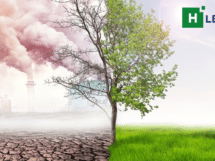Climate change made a severe rise in heat in India and Pakistan 30 times more likely, says a study by Extreme Event Attribution.
Two people were killed on May 30 when dust storms and heavy rains lashed various areas of Delhi and the National Capital Region (NCR) bringing the capital city to a standstill for hours as the storm caused chaos, catching people off guard.
While sitting in a cosy office space in faraway Kolkata, a few of us discussed the frequent rains, storms, and heat stress that leave people affected and even dead. A noted professor among us observed that if rare storms become frequent, humans would gradually adapt to the changing situations. He had a valid point, and common people often struggle with this thought. So why are climate scientists raising an SOS alarm, most people ask.
On May 15, 2022, the India Meteorological Department (IMD) released its data that marked its observing stations reporting temperatures between 45°C (113°F) and 50°C (122 °F). This trend followed a wave of severe heat at the end of April and early May, at which temperatures reached as high as 43-46 °C in the subcontinent.
According to a study by Extreme Event Attribution (EEA), climate change made devastating early heat in India and Pakistan 30 times more likely. The EEA, an emerging field of climate science, assesses reliable estimates of changing risks of extreme weather through a collaborative scientific approach.
This World Weather Attribution (WWA) initiative is a collaborative huddle of climate scientists from across the world such as from Imperial College London in the UK, KNMI in the Netherlands, IPSL/LSCE in France, Princeton University and NCAR in the US, ETH Zurich in Switzerland, IIT Delhi in India and climate impact specialists at the Red Cross / Red Crescent Climate Centre (RCCC). Their research provides robust assessments of the role of climate change in the aftermath of the heat event in the subcontinent. The partnership helps strengthen early warnings, early action, and implementation of heat-health action plans.
The widespread, prolonged heat, with below-average rainfall, impacted millions of people in one of the most densely populated areas of the world, the scientists found. The study says that such adverse impacts will affect people more frequently now, as the heat inflicts non-alterable damage to the planet.
The WMA report mentions that the 2022 heatwave has led to at least 90 deaths across India and Pakistan. It has triggered an extreme Glacial Lake Outburst Flood in northern Pakistan and forest fires in India. As a result, the heat stress is bound to reduce India’s wheat crop yields, reversing the government of India’s earlier plans to supplement the global wheat supply that was affected by the war in Ukraine.
In India, the coal shortage led to power outages and limited access to cooling, thus multiplying adverse health impacts. It forced millions of people to use coping mechanisms such as limiting activity in the early morning and evening. A heat stress event would have been about 1C cooler in a preindustrial climate.
Notably, this early heatwave was accompanied by much below-average rainfall and humidity. In India and Pakistan, extreme heat hits hardest the people who go outside their homes to earn a daily wage, such as street vendors, construction and farm workers, and traffic police. They consequently lack access to regular electricity and cooling at home, limiting their options to cope with prolonged heat stress. The daily productivity levels of daily wagers go down remarkably, affecting their lives and livelihood for a long time.
The rising temperatures from more intense and frequent heat waves are expected to render coping mechanisms inadequate as conditions in some areas meet and exceed limits to human endurance. In addition, mitigating further warming is essential to avoid further losing life and livelihood. While some losses unavoidably occur due to extreme heat, it is confusing to assume that the impacts are inevitable. Adaptation to extreme heat is definitely effective at reducing mortality in the long run. But the adverse health impacts with irreversible damages affect people now.
Heat Action Plans, including early warning and early response, awareness generation, behavioural changes and campaigns, and supportive public services, can help reduce mortality. India has rolled out some public engagement plans to address these issues remarkably, covering 130 cities and towns.
These efforts make the professor’s observation correct when he says humans will gradually adapt to the changing climate and probable heat waves. The uproar is about the present and the fast-changing situation with dire consequences. Scientists are upset about what happens now.
















